Design of DC Accumulator Charging using Backup Accumulator Based on Inverter and Converter Device
DOI:
https://doi.org/10.32497/eksergi.v18i2.3605Keywords:
backup DC accumulator, DC inverter, DC converter, charging energy and internal DC accumulator.Abstract
The charging of DC accumulator that
experiences a lack of electric charge energy, usually
utilizes an AC input power from the PLN network. When
the AC input power from the PLN network is unavailable,
a DC power source is used from the backup DC
accumulator as a substitute. The research objective is to
design an internal DC accumulator charging using a
backup DC accumulator equipment based on inverter
and converter equipment. The charging system will use
input power from the backup DC accumulator to replace
the AC input power from the PLN network. The electric
voltage of the internal DC accumulator that is filled
(charged) is the initial condition of V
DC(Acu.Int.)= 8.76 Volts
until it reaches the normal condition of 12.05 Volts with a
capacity of charging current of 5 Ah (Ampere.hours)
absorbs electrical energy of W(Acu.Int.)
= 16.45 Wh(Watt.hours). The results show that the equipment supply
a DC charger of 13.0 volts and PDC
of 21.32 watts to theinternal DC accumulator. The comparison of W
(Acu.Int.) to PDC produces time charging, t(charging)of 46.29 minutes
References
[Siti Nurhabibah,et al. 2017] Hutagalung, Melda Panjaitan (2017), Protype Rangkaian Inverter DC ke AC 900 watt, Jurnal Pelita Informatika, Volume 6, Nomor 1, ISSN 2301-9425, Media Cetak, hal: 64-66.
[Umar H. et al 2015] Dedid Cahya. (2015), Sistem Charging Baterai Pada Perancangan Mobil Hybrid. Surabaya.
https://www.edukasielektronika.com/2015/05/cara-menghitung-lama-waktu-pemakaian.html.
[Shoji Iida, et.al 1988] , Improved Voltage Source Inverter With 18 Step Output Waveforms,IEEE Trans. On Ind. Appl.
http://www.inverterplus.com/2010/04/power inverter. html, Power Inverter, 2010 .
http://gudang-jaya.com/?vwdtl=ya&pid=1086&kid =all.html, Gudang Jaya Electronic, Produk TV, 2011, di akses Juni 2021.
http://zakizi.blogspot.com/2011/01/arusyang-ideal-untuk-harge-pengisian.html, Arus yang Ideal untuk Charge/Pengisian Aki, 2011.
[Yosi A. 2018], Taufik Barlian (2018), INVERTER BERBASIS ACCUMULATOR SEBAGAI ALTERN TIF PENGHEMAT DAYA LISTRIK RUMAH TANGGA, Jurnal Surya Energi Vol. 3 No. 1,ISSN 2528-7400, hal. 213-2019.
[Abidin, Z. et al 2014], Aribowo, Desmira, D. (2016), Penyedia Daya Cadangan Menggunakan Inverter. Jurnal INTEKNA, Tahun XIV, No. 2 : 102 ”“ 209.
[Sudeep Pyakuryal, 2013], M. Matin (2013), Filter Design for AC to DC Converter, Department of Electrical and Computer Engineering University of Denver , IRJES-ISSN 2319-1821, Volume 2, PP. 42-49.
[Rusman 2019], Shanty (2019), RANCANG BANGUN SISTIM PENGISIAN BATERAI OTOMATIS GENSET TIPE RIDER DI KAMPUS KEMARITIMAN POLNES SAMARINDA, Jurnal TURBO ISSN 2301-6663 Vol. 3 N0. 2 , hal. 24-27.
[Panggabean S et. al 2017], Setyawan, F., Alam, S. (2017), Rancang Bangun Inverter Satu Fasa Menggunakan Teknik High Voltage PWM (Pulse Width Modulation), jurnal Electrician, hal. 72-80.
[Pekik Argo 2019], Topologi Konverter DC-DC, https://konversi.wordpress.com/topologi-konverter-dc-dc.
[P. Kumari, R. et al 2017], Keshari, and Banerjee (2017), Design and implementation of photovoltaic module using multilevel inverter and boost converter, Int. Res. J. Eng. Technol., vol. 4, no. 11, pp. 1064”“1068.
[Atmam et al 2017] , Elvira Z. , Zulfahri (2017), ANALISIS PENGGUNAAN ENERGI LISTRIK PADA MOTOR INDUKSI SATU PHASA DENGAN MENGGUNAKAN INVERTER, Jurnal Sain, Energi, Teknologi & Industri, Vol. 1 No. 2, pp. 1 ”“ 8.
Downloads
Additional Files
Published
Issue
Section
License
Authors who publish with this journal agree to the following terms:Authors retain copyright and grant the journal right of first publication with the work simultaneously licensed under a Creative Commons Attribution License that allows others to share the work with an acknowledgement of the work's authorship and initial publication in this journal.
Authors are able to enter into separate, additional contractual arrangements for the non-exclusive distribution of the journal's published version of the work (e.g., post it to an institutional repository or publish it in a book), with an acknowledgement of its initial publication in this journal.
Authors are permitted and encouraged to post their work online (e.g., in institutional repositories or on their website) prior to and during the submission process, as it can lead to productive exchanges, as well as earlier and greater citation of published work (See The Effect of Open Access).






